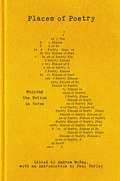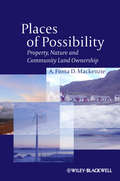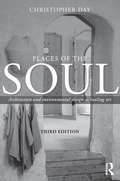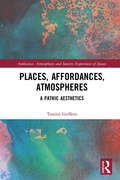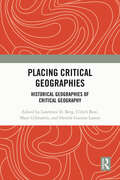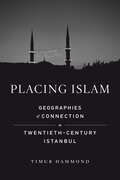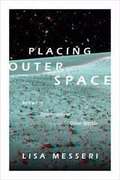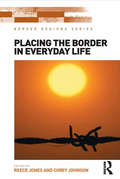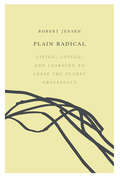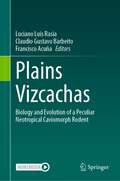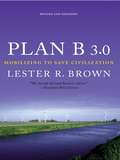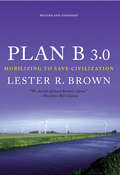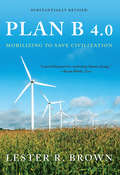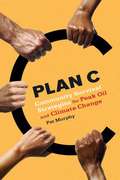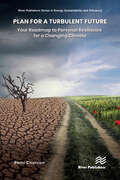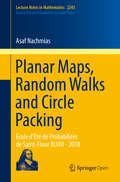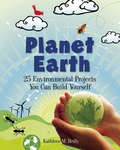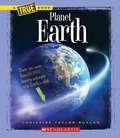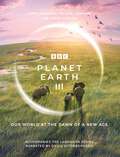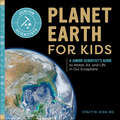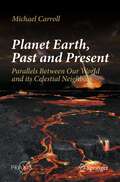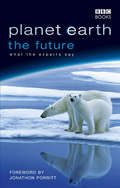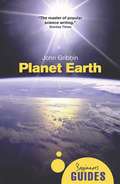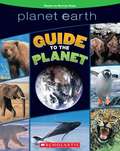- Table View
- List View
Places of Poetry: Mapping the Nation in Verse
by Andrew McRaePresenting the best poems from the nationwide Places of Poetry project, selected from over 7,500 entries Poetry lives in the veins of Britain, its farms and moors, its motorways and waterways, highlands and beaches. This anthology brings together time-honoured classics with some of the best new writing collected across the nation, from great monuments to forgotten byways. Featuring new writing from Kayo Chingonyi, Gillian Clarke, Zaffar Kunial, Jo Bell and Jen Hadfield, Places of Poetry is a celebration of the strangeness and variety of our islands, their rich history and momentous present.
Places of Possibility: Property, Nature and Community Land Ownership (Antipode Book Series)
by A. Fiona MackenzieThrough original research conducted in the Outer Hebrides, Scotland, Places of Possibility shows how community land ownership can open up the political, social, environmental, and economic terrain to more socially just and sustainable possibilities than private ownership. Reveals how community land ownership is more just and sustainable than private ownership Features original theoretical insights into ideas of property and nature that disrupt the process of neoliberalisation Based on original research conducted by the author in the Outer Hebrides, Scotland
Places of the Soul: Architecture and environmental design as a healing art
by Christopher DayFor Christopher Day, architecture isn’t just about the appearance of buildings but how they’re experienced as places to be in. Occupants’ experience can differ radically from designers’ intentions as their concerns and thinking differ. Additionally, multi-sensory ambience, spatial sequential experience and embodied spirit resonate in the human soul. Sustainable design means much more than energy-efficiency: if sustainable buildings don’t also nourish the soul, occupant-building interaction will lack care and eco-technologies won’t be used efficiently. This major revision of his classic text builds on more than forty years of experience ecological design across a range of climates, cultures and budgets, and 25 years hands-on building. Treating buildings as environments intrinsic to their surroundings, the book explores consensus design, economic and social sustainability, and how a listening approach can grow architectural ideas organically from the interacting, sometimes conflicting, requirements of place, people and situation. This third edition, comprehensively revised to incorporate new knowledge and address new issues, continues Day’s departure from orthodox contemporary architecture, offering eye-opening insights and practical design applications. These principles and guidelines will be of interest and value to architects, builders, planners, developers and homeowners alike. Reviews of the first edition ... one of the seminal architecture books of recent times Professor Tom Wooley, Architects Journal The 'bible' of many architects and those interested in architecture. Centre for Alternative Technology ... an inspiration to all those who care about the influence of the environment on Man’s health and well-being. Barrie May, The Scientific and Medical Network At last an architect has written a sensitive and caring book on the effects of buildings on all our lives. Here’s Health This gentle book offers a route out of the nightmare of so much callous modern construction. I was inspired. Colin Amery, The Financial Times
Places, Affordances, Atmospheres: A Pathic Aesthetics (Ambiances, Atmospheres and Sensory Experiences of Spaces)
by Tonino GrifferoThis book offers a diverse understanding and practical approach towards the growing area of atmosphere research, in the context of philosophy, geography and architecture. It begins by tracing back to the model of experience called the "pathic". Drawing on the phenomenology of theorists Hermann Schmitz and Gernot Böhme, introductory chapters offer a grounding for the beginnings of pathic research. The chapters go on to apply pathic framework to a range of practical cases from theatre studies to education. Atmospheres are often defined as affects one feels in a "lived space" and researchers are becoming more interested in the emotions we feel in natural and artificial environments across day to day life. By providing a critical re-evaluation of phenomenology and aesthetics, the book brings a series of unexplored and controversial subjects to light, opening up a new context for thinking about our everyday life and experiences inscribed within aesthetics, politics, literature, spatial practices and pedagogy and effectively merging abstract philosophy and concrete practice. This book is particularly poignant in the emerging field of Atmosphere and New Aesthetics research. Practitioners, academics and researchers working within Cultural Geography, Aesthetics, Art and Philosophy will find this book extremely valuable.
Placing Critical Geography: Historical Geographies of Critical Geography
by Mary Gilmartin Henrik Gutzon Larsen Lawrence D. Berg Ulrich BestThis book explores the multiple histories of critical geography as it developed in 14 different locations around the globe, whilst bringing together a range of approaches in critical geography. It is the first attempt to provide a comprehensive account of a wide variety of historical geographies of critical geography from around the world. Accordingly, the chapters provide accounts of the development of critical approaches in geography from beyond the hegemonic Anglo-American metropoles. Bringing together geographers from a wide range of regional and intellectual milieus, this volume provides a critical overview that is international and illustrates the interactions (or lack thereof) between different critical geographers, working across a range of spaces. The chapters provide a more nuanced history of critical geography, suggesting that while there were sometimes strong connections with Anglo-American critical geography, there were also deeply independent developments that were part of the construction of very different kinds of critical geography in different parts of the world. Placing Critical Geographies provides an excellent companion to existing histories of critical geography and will be important reading for researchers as well as undergraduate and graduate students of the history and philosophy of geography.
Placing Islam: Geographies of Connection in Twentieth-Century Istanbul (Islamic Humanities #4)
by Timur Warner HammondA free ebook version of this title is available through Luminos, University of California Press’s Open Access publishing program. Visit www.luminosoa.org to learn more. For centuries, the Mosque of Eyüp Sultan has been one of Istanbul’s most important pilgrimage destinations, in large part because of the figure buried in the tomb at its center: Halid bin Zeyd Ebû Eyûb el-Ensârî, a Companion of the Prophet Muhammad. Timur Hammond argues here, however, that making a geography of Islam involves considerably more. Following practices of storytelling and building projects from the final years of the Ottoman Empire to the early 2010s, Placing Islam shows how different individuals and groups articulated connections among people, places, traditions, and histories to make a place that is paradoxically defined by both powerful continuities and dynamic relationships to the city and wider world. This book provides a rich account of urban religion in Istanbul, offering a key opportunity to reconsider how we understand the changing cultures of Islam in Turkey and beyond.
Placing Nature: Culture And Landscape Ecology
by Joan Nassauer Chris FaustLandscape ecology is a widely influential approach to looking at ecological function at the scale of landscapes, and accepting that human beings powerfully affect landscape pattern and function. It goes beyond investigation of pristine environments to consider ecological questions that are raised by patterns of farming, forestry, towns, and cities.Placing Nature is a groundbreaking volume in the field of landscape ecology, the result of collaborative work among experts in ecology, philosophy, art, literature, geography, landscape architecture, and history. Contributors asked each other: What is our appropriate role in nature? How are assumptions of Western culture and ingrained traditions placed in a new context of ecological knowledge? In this book, they consider the goals and strategies needed to bring human-dominated landscapes into intentional relationships with nature, articulating widely varied approaches to the task.In the essays: novelist Jane Smiley, ecologist Eville Gorham, and historian Curt Meine each examine the urgent realities of fitting together ecological function and culture philosopher Marcia Eaton and landscape architect Joan Nassauer each suggest ways to use the culture of nature to bring ecological health into settled landscapes urban geographer Judith Martin and urban historian Sam Bass Warner, geographer and landscape architect Deborah Karasov, and ecologist William Romme each explore the dynamics of land development decisions for their landscape ecological effects artist Chris Faust's photographs juxtapose the crass and mundane details of land use with the poetic power of ecological pattern.Every possible future landscape is the embodiment of some human choice. Placing Nature provides important insight for those who make such choices -- ecologists, ecosystem managers, watershed managers, conservation biologists, land developers, designers, planners -- and for all who wish to promote the ecological health of their communities.
Placing Outer Space: An Earthly Ethnography of Other Worlds
by Lisa MesseriIn Placing Outer Space Lisa Messeri traces how the place-making practices of planetary scientists transform the void of space into a cosmos filled with worlds that can be known and explored. Making planets into places is central to the daily practices and professional identities of the astronomers, geologists, and computer scientists Messeri studies. She takes readers to the Mars Desert Research Station and a NASA research center to discuss ways scientists experience and map Mars. At a Chilean observatory and in MIT's labs she describes how they discover exoplanets and envision what it would be like to inhabit them. Today's planetary science reveals the universe as densely inhabited by evocative worlds, which in turn tells us more about Earth, ourselves, and our place in the universe.
Placing the Border in Everyday Life (Border Regions Series)
by Reece Jones Corey JohnsonBordering no longer happens only at the borderline separating two sovereign states, but rather through a wide range of practices and decisions that occur in multiple locations within and beyond the state’s territory. Nevertheless, it is too simplistic to suggest that borders are everywhere, since this view fails to acknowledge that particular sites are significant nodes where border work is done. Similarly, border work is more likely to be done by particular people than others. This book investigates the diffusion of bordering narratives and practices by asking ’who borders and how?’ Placing the Border in Everyday Life complicates the connection between borders and sovereign states by identifying the individuals and organizations that engage in border work at a range of scales and places. This edited volume includes contributions from major international scholars in the field of border studies and allied disciplines who analyze where and why border work is done. By combining a new theorization of border work beyond the state with rich empirical case studies, this book makes a ground-breaking contribution to the study of borders and the state in the era of globalization.
Plain Radical: Living, Loving and Learning to Leave the Planet Gracefully
by Robert JensenThere was nothing out of the ordinary about Jim Koplin. He was just your typical central Minnesota gay farm boy with a Ph.D. in experimental psychology who developed anarchist-influenced, radical-feminist, and anti-imperialist politics, while never losing touch with his rural roots. But perhaps the most important thing about Jim is that throughout his life, almost literally to his dying breath, he spent some part of every day on the most important work we have: tending the garden.Plain Radical is a touching homage to a close friend and mentor taken too soon. But it is also an exploration of the ways in which an intensely local focus paired with a fierce intelligence can provide a deep, meaningful, even radical engagement with the world.Drawing on first hand accounts as well as the nearly 3,000 pages of correspondence that flowed between the two men between 1988 and 2012, this book is about the intersection of two biographies and the ideas two men constructed together. It is in part a love story, part intellectual memoir, and part political polemic; an argument for how we should understand problems and think about solutions-in those cases when solutions are possible-to create a decent human future.
Plains Vizcachas: Biology and Evolution of a Peculiar Neotropical Caviomorph Rodent
by Luciano Luis Rasia Claudio Gustavo Barbeito Francisco AcuñaThe plains vizcacha (Lagostomus maximus) is a remarkable rodent of the Neotropic given several peculiar aspects of its biology, some of them quite unique among rodents or even among mammals. This book gathers specialists studying plains vizcachas from very different approaches, including paleontology, systematics, morphology, physiology, development and conservation. It is divided in two Parts, 1) Evolutionary History, and 2) Morphology, Development and Physiology. It will surely be a required reading for any researcher working with caviomorph rodents, mastozoology of the Neotropics or internal anatomy and physiology of mammals.
Plan B 3. 0: Mobilizing to Save Civilization
by Lester R. BrownThe world faces many environmental trends of disruption. This book has a survival strategy for the early twenty-first-century civilization.
Plan B 3.0: Mobilizing to Save Civilization (Substantially Revised)
by Lester R. Brown"How to build a more just world and save the planet....We should all heed Brown's advice."--Bill Clinton In this updated edition of the landmark Plan B, Lester Brown outlines a survival strategy for our early twenty-first-century civilization. The world faces many environmental trends of disruption and decline, including rising temperatures and spreading water shortage. In addition to these looming threats, we face the peaking of oil, annual population growth of 70 million, a widening global economic divide, and a growing list of failing states. The scale and complexity of issues facing our fast-forward world have no precedent With Plan A, business as usual, we have neglected these issues overly long. In Plan B 3.0, Lester R. Brown warns that the only effective response now is a World War II-type mobilization like that in the United States after the attack on Pearl Harbor.
Plan B 4.0: Mobilizing to Save Civilization (Substantially Revised)
by Lester R. Brown"[Brown's] ability to make a complicated subject accessible to the general reader is remarkable."--Katherine Salant, Washington Post As fossil fuel prices rise, oil insecurity deepens, and concerns about climate change cast a shadow over the future of coal, a new energy economy is emerging. Wind, solar, and geothermal energy are replacing oil, coal, and natural gas, at a pace and on a scale we could not have imagined even a year ago. For the first time since the Industrial Revolution, we have begun investing in energy sources that can last forever. Plan B 4.0 explores both the nature of this transition to a new energy economy and how it will affect our daily lives.
Plan C: Community Survival Strategies for Peak Oil and Climate Change
by Pat MurphyA sustainability expert goes beyond renewables, calling on us to combat the climate crisis with a new, low-energy way of life.Concerns over climate change and energy depletion are increasing exponentially. Mainstream solutions still assume that some miracle will cure our climate ills without requiring us to change our energy-intensive lifestyle. But switching from fossil fuels to renewable energy sources isn’t enough. We need a Plan C.In response to the converging crises of Peak Oil, climate change, and increasing inequity, sustainability expert Pat Murphy offers an inspiring vision of community and curtailment. Where cooperation replaces competition, we can deliberately reduce consumption of consumer goods. Plan C shows how each person's individual choices can dramatically reduce CO2 emissions, offering specific strategies in the areas of food, transportation, and housing.
Plan for a Turbulent Future: Your Roadmap to Personal Resilience for a Changing Climate
by Remi CharronMillions of lives and businesses have either been lost or significantly impacted by COVID-19. Yet, many are warning that climate change will be much more devastating over the coming decades. Reality is starting to set in. We are not going to achieve our global mitigation targets; we probably won’t even come close. Individuals faced with this reality react differently, from willful ignorance to anxiety and depression, all normal reactions. If you believe in science and understand the likelihood of our failure to meet our targets, you need to accept and plan for an unknown, challenging future. We may be individually powerless to stop climate change, but we certainly can act in ways that will help us better face the consequences. This book provides a structured approach to plan and prepare today for a world rocked by a turbulent climate.
Planar Maps, Random Walks and Circle Packing: École d'Été de Probabilités de Saint-Flour XLVIII - 2018 (Lecture Notes in Mathematics #2243)
by Asaf NachmiasThis open access book focuses on the interplay between random walks on planar maps and Koebe’s circle packing theorem. Further topics covered include electric networks, the He–Schramm theorem on infinite circle packings, uniform spanning trees of planar maps, local limits of finite planar maps and the almost sure recurrence of simple random walks on these limits. One of its main goals is to present a self-contained proof that the uniform infinite planar triangulation (UIPT) is almost surely recurrent. Full proofs of all statements are provided. A planar map is a graph that can be drawn in the plane without crossing edges, together with a specification of the cyclic ordering of the edges incident to each vertex. One widely applicable method of drawing planar graphs is given by Koebe’s circle packing theorem (1936). Various geometric properties of these drawings, such as existence of accumulation points and bounds on the radii, encode important probabilistic information, such as the recurrence/transience of simple random walks and connectivity of the uniform spanning forest. This deep connection is especially fruitful to the study of random planar maps. The book is aimed at researchers and graduate students in mathematics and is suitable for a single-semester course; only a basic knowledge of graduate level probability theory is assumed.
Planet Earth
by Farah Rizvi Kathleen M. ReillyPlanet Earth: 25 Environmental Projects You Can Build Yourself provides an engaging guide to the natural world and encourages children ages 9 and up to get their hands dirty and actively connect with the environment. It then introduces key environmental issues-wind and solar power, pollution, endangered species, global warming, and recycling-and posits potential solutions. Trivia, fun facts, and 25 captivating hands-on projects investigate ecology basics, such as the food chain, oxygen, and animal habitats, as well as ways to lessen the strain on Earth's resources by reducing human consumption and waste. With Planet Earth kids will learn how to respect and protect our unique planet.
Planet Earth (A True Book)
by Christine ButlerEarth stands out as the only planet in the solar system that is known to support life. <P><P>A True Book: Space series dives into the many components that make each planet distinctive and exceptional, as well as explore many of the other components that make up Space. This series includes an age appropriate (grades 3-5) introduction to curriculum-relevant subjects and a robust resource section that encourages independent study. Lexile Measure: 850 <P><P>Even though this remarkable planet is our home, we still have plenty to learn about it. Readers will discover why Earth is so perfectly suited for hosting a variety of life forms. They will also learn how ancient philosophers used their observations to learn about Earth's role in the solar system and how modern scientists are studying the planet today.
Planet Earth III: Accompanies the Landmark Series Narrated by David Attenborough
by Jonny Keeling Matt Brandon Michael GuntonThe official tie-in to the third instalment in the legendary Planet Earth franchiseFew places on Earth remain untouched by humans, creating challenges for the wildlife we share it with. We have entered a new age, and we must look at the splendour of the natural world through a different lens.From the depths of our oceans, to scorching deserts and the most remote jungles, Planet Earth III features spectacular places and surprising animal behaviours from all corners of our world. And for the first time, a human element is introduced to each landscape, highlighting how, in the age of the Anthropocene, today's planet has been forever changed by humanity and that wildlife now faces new challenges in our crowded, modern world.Featuring over 250 beautiful full-colour photographs, Planet Earth III reveals the wonders and trials of life on an increasingly fragile planet, bringing you closer than ever before to our world’s most intriguing species, unseen landscapes and natural phenomena.
Planet Earth for Kids: A Junior Scientist's Guide to Water, Air, and Life in Our Ecosphere (Junior Scientists)
by Stacy W KishExplore the land, water, and sky with the Junior Scientists series for kids ages 6 to 9 Have you ever wondered what makes the weather change? Or how mountains, rivers, and valleys get their shapes? Answer these questions and more with Planet Earth for Kids! You'll explore how our planet became the perfect home for all its plants and animals and how our air, sun, water, and dirt make planet Earth unique.Photos and illustrations—Beautiful pictures and fascinating diagrams let you take a peek at everything from penguins and storm clouds to the different types of rocks.Facts and activities—Discover what causes volcanoes, how much salt is really in the ocean, and even how to build your own solar-powered pizza oven!Earth ecosystems—Learn about the different biomes and habitats all over planet Earth and the plants and animals that work together to keep them healthy.Find out what keeps all life on Earth in balance with Planet Earth for Kids.
Planet Earth, Past and Present: Parallels Between Our World and its Celestial Neighbors (Springer Praxis Books)
by Michael CarrollThe Earth is not the world it once was, and it is not the world it will always be. This book describes the exciting, complex, and occasionally baffling history of our own planet. Over the course of its 4.5 billion years, Earth has undergone astonishing changes to its surface and atmosphere, at times more closely resembling other planets in our Solar System than the habitable, teeming biosphere of today. Through these otherworldly analogs, author-illustrator Michael Carroll teaches readers about different aspects of our own planet’s past. Our nearest cosmic neighbor, Venus, offers insights into Earth’s own young atmosphere and surface, while Saturn’s moon Titan may offer a window into the genesis of life on Earth. Planet Earth, Past and Present explores these and many more connections. Original art accompanies each chapter, depicting major stages of the Earth’s evolution and providing vivid comparisons to other planets or moons. Come along on this journey through the Solar System—a journey that ultimately leads us home.
Planet Earth, The Future
by Fergus Beeley Jonathan Porritt Rosamund Kidman CoxPlanet Earth is the most spectacular look at our planet that has ever been broadcast. It has made millions of viewers aware of the breathtaking beauty and variety of life on our planet, and just as importantly how fragile that life can be. The premise of Planet Earth - The Future is to identify environmental and conservation issues that surround some of the sequences in Planet Earth, and put these issues to leading commentators, including NGO's, politicians and religious leaders James Leape (WWF International), Jeffrey McNeely (World Conservation Union), and the Archbishop of Canterbury to name but a few of the 35 contributors. We are living in destructive times, and our responsibility for the planet's stewardship is something none of us can afford to ignore. Comprised of transcripts from the series interviews, thoughtfully edited and abbreviated, this compelling and insightful book serves as a timely reminder of what needs to be done and what can be done to keep Planet Earth alive.
Planet Earth: A Beginner's Guide (Beginner's Guides)
by John GribbinIn this incredible expedition into the origins, workings, and evolution of our home planet, John Gribbin, bestselling author of In Search of Schrödinger's Cat, The Scientists, and In Search of the Multiverse, does what he does best: taking four and a half billion years of mind-boggling science and digging out the best bits. From the physics of Newton and the geology of Wegener, to the environmentalism of Lovelock, this is a must read for Earth's scientists and residents alike. Trained as an astrophysicist at Cambridge University, John Gribbin is currently Visiting Fellow in Astronomy at the University of Sussex, England.
Planet Earth: Guide To The Planet
by Steve MurrieAre you ready for the highest, lowest, hottest, coldest, darkest, brightest, wildest, and windiest locations on Earth? They're all here, along with the incredible animals that inhabit them. It's the official guide to your whole world.
